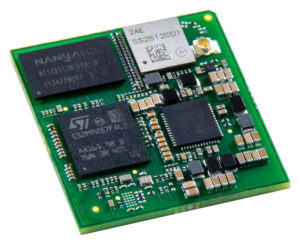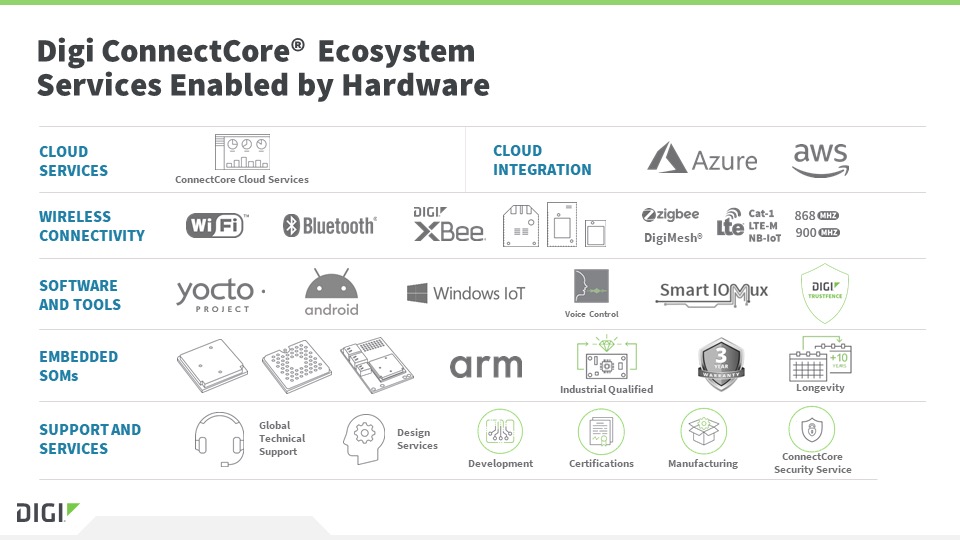Digi jumped on the STM32MP25 bandwagon with its newly released Digi ConnectCore® MP2, its first system-on-module (SoM) based on our new series of microprocessors. The company even showcased its arrival at Sido 2024, a trade show focused on IoT, AI, XR, and robotics, last September in France.
This is not their first STM32 SoM, which makes it all the more interesting. How hard was it for Digi to release this new Som and what are they offering customers? Indeed, the member of the ST Partner program is famous for providing one of the most comprehensive end-to-end ecosystems, so developers get security, graphical user interfaces, cloud connectivity, and more. Let’s, therefore, study the impact of an ecosystem on a project or why a SoM is more than the sum of its hardware components.
What’s new? The Digi ConnectCore MP2

The Digi ConnectCore MP2 comes with up to 128 GB of eMMC flash and 2 GB of DDR4. Digi also uses the STPMIC25, our power management IC designed for PCBs using an STM32MP25. Thanks to its regulators, seven buck SMPS, six adjustable LDOs, and more, it simplifies the integration of our new MCU by making the PCB layout design more straightforward. This partly explains why Digi could come up with a new SoM so rapidly. Moreover, the SoM also features a dual-band Wi-Fi 6 (802.11 ax) and Bluetooth® 5.4 module while offering the ability to connect to a cellular model and adopting a small form factor of only 30 mm x 30 mm.
The Digi ConnectCore MP1x
Digi provides two STM32MP1 SoMs, the Digi ConnectCore MP15, and the ConnectCore MP13, which are the smallest wireless SoMs available with a form factor of just 29 mm x 29 mm. The modules incorporate a Wi-Fi 5 (802.11a/b/g/n/ac) and a Bluetooth 5.2 radio. Customers also get up to 1 GB of DDR3L and 1 GB of SLC NAND flash. The ST Authorized Partner also used the STPMIC1A within the MP15 for the power management IC, thus allowing the company to create the densest wireless SoM on the market. As for the ConnectCore MP13, it houses an STM32MP13, our most affordable and fastest single-core MPU.
Digi’s experience with the ConnectCore MP13 and MP15 explains how the company could launch its ConnectCore MP25 rapidly, as many of the lessons it learned with the previous generation of MPUs were transferable. In all cases, ConnectCore modules stand out from the crowd thanks to a comprehensive hardware portfolio that covers a broad range of performance and cost while providing a small form factor and flexible connectivity. Digi designed the modules for industrial and medical use cases with high security, reliability, performance, and ten-year longevity.
An ecosystem to reduce the time to market
It’s not just the STM32 MPU SoMs but the ecosystem around it

Digi explained how they used to design their MPUs but learned they could offer more added value by working with a partner like ST to create an ecosystem instead of focusing on silicon. For instance, many engineers jumpstart their product development by leveraging Digi Embedded Yocto to create a Linux distribution optimized for their application. Additionally, Digi Wireless Design Services (WDS) helps companies by embedding wireless applications and building products from concept to production.
The ST Authorized Partner also offers security building blocks within the ConnectCore solution: Digi TrustFence® (integrated security features such as authentication); Digi ConnectCore Security Services (enabling security management throughout the entire product lifecycle); and Digi ConnectCore Cloud Services (enabling maintenance with secure over-the-air software updates).
It’s not just an ecosystem but a way to get things done
The member of the ST Partner Program shared how its teams started by embracing OpenSTLinux, the fully mainline Linux distribution from ST for the STM32MPU family. Its engineers then added middleware to handle security, UIs, wireless communication, and more. Their goal was to ensure that developers only had to deal with one company, Digi, for all or almost all their needs, from Linux drivers to cloud and security services. Developers can thus grab a Digi SoM, and its ecosystem helps them focus on their core business to distinguish their products from the competition better.
An example of the tools available in the Digi ConnectCore ecosystem is Smart IOmux. Today’s MCUs and MPUs allow several functions to be multiplexed on a single pin, enabling more functionality and flexibility but complicating the processor’s initialization operation. Digi ConnectCore Smart IOmux provides a graphical interface to simplify the process and resolve potential conflicts. The tool even exports the Linux device tree file to configure the kernel.
Security as a means to greater markets
Digi security building blocks or how to think about security

One example of the philosophy behind Digi’s ecosystem is its Digi TrustFence security framework, which supports a wide range of security features. Its IoT security facilitates the implementation of a secure boot and hardens hardware and network ports. The framework also applies data authentication, provides device identity management options, and leverages the latest encryption protocols to ensure data integrity, among other functionalities. Another security building block is Digi ConnectCore Security Services, which provides frequent scanning for vulnerabilities that may come up after the initial product release. The ST Authorized Partner also offers ConnectCore Cloud Services, which help establish secure OTA software updates, enable process automation and remote device management to lower the overall costs and minimize downtime.
Applications as an example of the end game for engineers
Accordingly, the Digi security blocks are so extensive that they can help obtain the HIPAA (Health Insurance Portability and Accountability Act) certification and US Food and Drug Administration (FDA) approvals necessary to sell medical devices. Indeed, too often, manufacturers avoid new markets like healthcare because of the stringent requirements they impose. However, one lesson from this case study should be that comprehensive ecosystems can enable developers to explore new markets. In this instance, by adopting TrustFence, ConnectCore Security Services, and ConnectCore Cloud Services, developers and integrators can envision using their STM32 MPU in new settings, like medical applications. Digi even offers a white paper to help teams navigate healthcare.

Even if engineers work on something less demanding, like a consumer IoT application, underestimating the security features required today could have seriously adverse effects. Nowadays, even the most basic cloud connection involves the exchange of keys and cryptographic capabilities. Moreover, legislators are increasingly mandating features like Root of Trust, which guarantees a system’s integrity, and over-the-air updates to patch vulnerabilities. Put simply, reporting security breaches is no longer enough. Consumers and legislators demand solutions and more proactive protection against threat actors. That’s why ST works closely with Digi. Thanks to its expertise, this ST Authorized Partner can jumpstart new projects running on STM32 MPUs and patch older software to help OEMs with long-term support.

